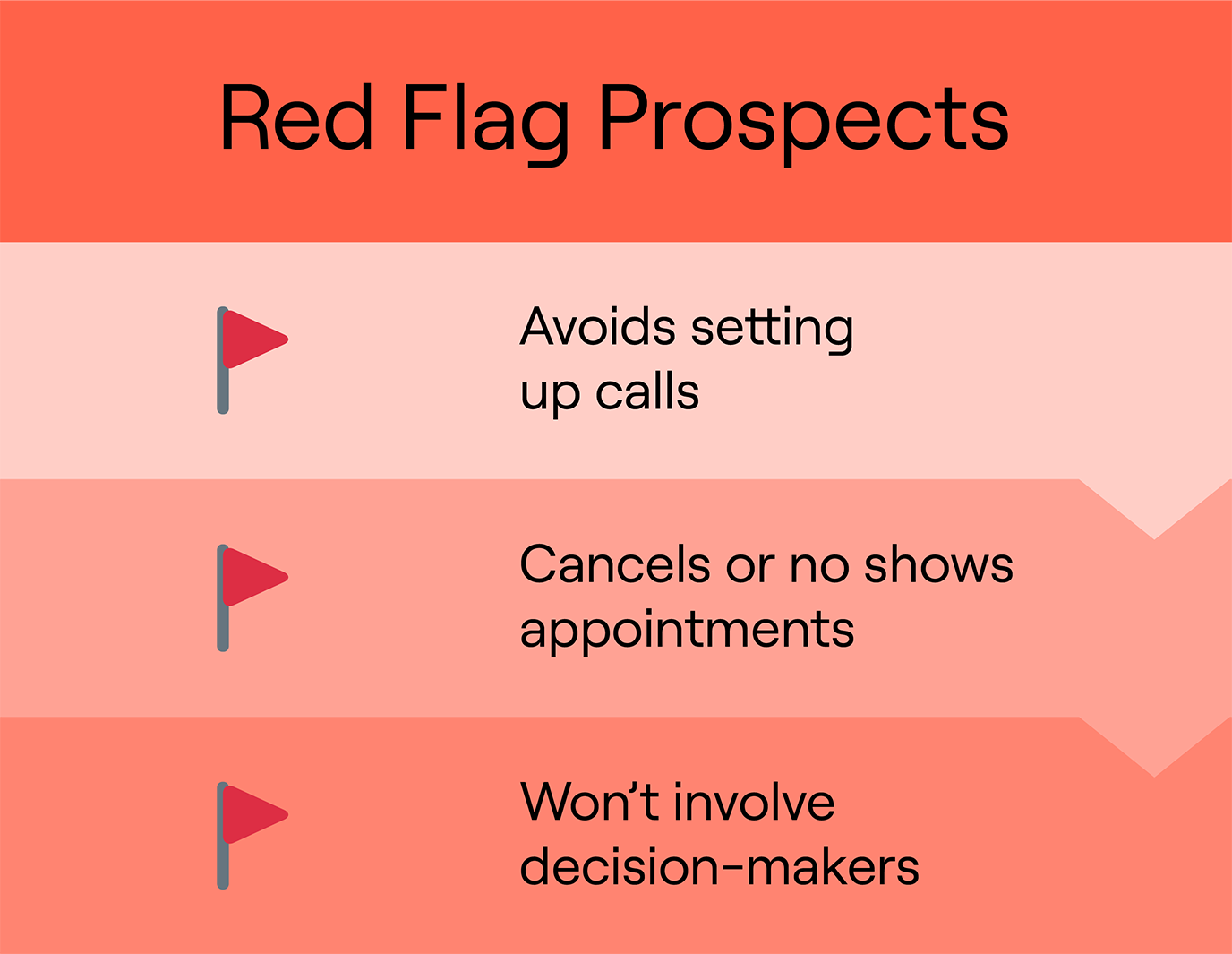Red Flag Prospects With Ryan Reisert
What's on this page:
Salespeople’s time is valuable. Every second wasted is less time to invest in creating the next business opportunity.
So it’s important that you use your time wisely. Sometimes, that means reading the signs that your prospect is wasting yours.
Not every prospect you call is going to be the right fit for your business!
Sales expert Ryan Reisert is a firm believer that he should only do business with people who are just as committed to the deal as he is.
Equal commitment will mean that there’s better deal velocity. As well as less wasted time chasing prospects who are never going to commit. Not to mention a higher likelihood of a good fit for both parties.
Interested? Keep reading for some of the red flags Ryan watches out for.
Stick to your swim lane
If you’re trying to maximise your opportunities, you’d assume that more people = better. Right?
Ryan disagrees. He says:
“Don’t try selling to everyone and everything. You’re going to waste so much time.”
“You feel busy, you feel like you’re doing the right things. You might even be having lots of meetings with people who are open to talking. But if nothing is closing, then it’s all for nothing. It’s also really expensive.”
Ryan learned this lesson the hard way. He had an open link for inbound requests - anyone could book onto his calendar.
However, this meant he was spending a huge amount of time with people who hadn’t been sales qualified. As many as six meetings a day!
He wanted to make it as easy as possible for people to get started using his product.
And he felt like this was great at first, ‘look at all this traction I’m getting!’
But this used a huge amount of internal resources. He also discovered almost none of these types of leads were closing.
Ryan says:
“It was a tremendous waste of time. I now only take inbound requests if I can see they’re in my swim lane - they’re a perfect fit.”
“I’d rather spend less time with more qualified prospects who end up closing. And the same for my sales team, I want them to be disqualifying wrong fit accounts quickly.”
Knowing when to say ‘I don’t think we’re a fit' and disqualifying misfit accounts is just as important as identifying the right ones. Streamlining your workflow and prioritising your time.
And then there’s also a subsection of your prospects - the ones who on the surface are a fit - but they’re dragging their feet. They aren’t committing to the next phase.
You might be reluctant to write them off because you don’t want to lose out on an opportunity. And we’re not suggesting you give up at the first sign of an objection.
But you can keep your eyes open for warning signs that suggest this prospect might not be worth chasing.
Red flags
Most sales trainers will teach their students to get their prospects to make ‘micro commitments’.
This means having small stages within your sales process where your prospect has to make small commitments.
This could be confirming a date for the next meeting or providing some feedback on a report.
The point of these micro commitments is to get deals moving faster and engaging elusive prospects. But they’re also useful to identify those who might not be on the same page.
Because if you can’t tie down a prospect to even these small commitments. They’re unlikely to say yes to a deal.
Ryan says:
“If your next interaction isn’t scheduled, it probably isn’t an opportunity.”Here are some of the red flags Ryan looks out for.

Avoids setting up calls
Is your prospect resistant to organising the next call?
To reiterate - we aren’t talking about the first or even second objection. Those are an inevitable part of cold calling.
We’d describe resistance as being super vague or evasive about the next scheduled interaction. Don’t forget, you’re trying to show them you can add value and solve a problem. You shouldn’t have to convince them to listen to you at every step.
Think of a sales conversation a little like dating.
You’re calling someone from a company to find out if you could be a good fit to help them. You put yourself out there, explaining your value and telling them what you’re looking for.
This person says ‘yeah it sounds like there’s a fit’ and you get excited. You think this could be the call you’ve been waiting for - a good fit account!
So you try to get another call in the diary. But you keep getting responses like, ‘I’m really busy right now…’ Or ‘I’m not really looking to switch providers at the moment.’
Your prospect seems to find every excuse for why they can’t set the next meeting. Or even worse, they stop replying altogether.
In this scenario, you have a couple of choices. You could spend lots of time chasing after them, trying to follow up, hoping that you can turn things around. Risking annoying this prospect out of any future deal in the process.
Or you could put them into another bucket where they can be gently nurtured until they’re ready instead. While you move on to your next best opportunity.
Ryan says:
“I get it, you want to close every deal you can. But not every deal is worth your time.”
“This has to be a two-way street, there has to be a commitment from either side for this to work.”
‘The amount of work it takes to get them on board, and then work through the problems that inevitably arise because they weren’t committed just doesn’t make sense.”
“There can be a huge reputational risk if you bring on the wrong people. You could be spending that time finding a better customer.”
Cancels or 'no show' appointments
Another red flag to look out for is if your prospect keeps rescheduling, cancelling or not showing up for appointments.
Firstly, it’s rude to schedule an appointment and then not show up. That might not be someone you’d be keen to do business with long term.
Secondly, continuously kicking the can down the road suggests they’re not ready to commit. Or they don’t respect the value of what you’re offering.
If a prospect was really suffering from the problem you solve, then they’d be keen to find out more about how you can help.
If the prospect keeps cancelling or worse, not showing up, then it’s clear they can’t be motivated to solve the problem.
Again, your time could be better used elsewhere.
Ryan says:
“Some people think I’m crazy. But if I get the impression the person I’m prospecting to isn’t actively engaged in solving a problem with me. I disqualify them.”
“I tell them something like:
‘It seems you’re not that committed to this process, so I’m making the assumption that maybe this isn’t such a great fit.’
“If they’re in your swim lane, then you should definitely be following up later on down the line. But they’re not your best opportunity right now.”
Won't involve decision-makers
Another red flag? When your prospect is acting as a steadfast gatekeeper. Hesitant to get other key decision-makers involved.
Normally it’s not just one person deciding to do deals on behalf of the company. There needs to be buy-in from multiple parties.
In an ideal world, you’d be prospecting all the relevant decision-makers from the beginning. But some are harder to get hold of than others.
So, your prospect appears to be a fit. They’ve been engaging in meetings but they’re avoiding including others who need to approve the deal. Then guess what?
Big red flag.
There’s obviously a reason they’re holding back. And you might be able to uncover this reason and resolve it. But if they’re not being upfront about their reasons why… then you might be wasting your time.
Again, this might be another candidate for the nurture bucket to follow up with at a later date.
Don’t force a fit
As a quota-carrying sales rep, it's easy to understand the motivation to try to make a square fit into a triangle-shaped hole.
You want to be providing a steady stream of opportunities. Especially when from the outside, your accounts look to be a great fit.
But if you ignore the red flags and potential problems highlighted during calls. You might end up with a whole bunch of meetings resulting in very little revenue.
Even if you do by some miracle manage to close one of these tricky-to-manage accounts, you might find there’s a lack of concentration when it comes to enablement and implementation.
You could be putting in all you can, but if the company you’re working with isn’t putting in the same level of effort to learn and apply your product, they probably aren’t going to see the desired results.
And this can lead to unsatisfied customers, bad reviews and short deal lengths. Making the time, money and effort put into acquiring this account less worthwhile.
It’s in your best interests - as well as your customers - to direct your resources towards the best fit, committed accounts.
The last word
You might be sick of the word commitment by the end of this article - we have used it a lot.
But there’s a reason for that.
Ryan believes commitment has to be at the centre of any sales exchange.
In fact, he recommends using that word in your sales conversations, for example:
- ‘I’m committed to delivering xyz.’
- ‘This is the problem I’m committed to solving.’
- ‘I’m here today to find out if there’s alignment in my commitment to help other people like you solve this problem. But I need you to commit with me along the way.’
And if commitment is missing from one side of your exchanges with a prospect, then chances are it’s not going to move very far.
For more sales insights from Cognism, sign up to our bi-weekly newsletter! Click below.



